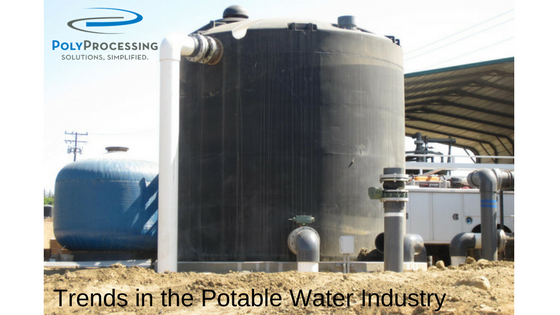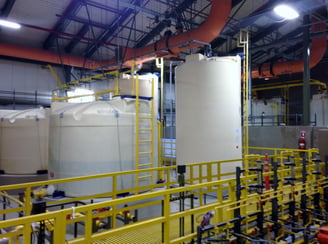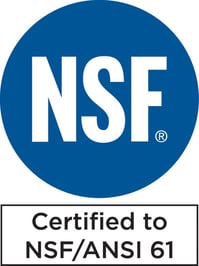Trends in the Potable Water Industry

In 2014, the water storage systems market in North America was valued at $2.45 billion, and it’s projected to top $4 Billion by 2020. As freshwater resources are becoming more scarce in growing population centers, and concerns over water conservation are increasing, potable water storage is becoming a big deal. Municipalities, commercial industries, and even residential markets need to make the most of their potable water storage systems.
 Potable water is any water that’s fit for human consumption. Most people think of drinking water, but it also includes water used in food and beverage production, fire suppression reserves, and rain water harvesting. Potable water can be stored in many types of containers—but there are only a few that are NSF/ANSI 61-certified for potable water tank.
Potable water is any water that’s fit for human consumption. Most people think of drinking water, but it also includes water used in food and beverage production, fire suppression reserves, and rain water harvesting. Potable water can be stored in many types of containers—but there are only a few that are NSF/ANSI 61-certified for potable water tank.
Often, giant concrete tanks are used to store potable water, but that’s not always the best option. Let’s take a look at how potable water tanks are used, and what type of tank makes sense for your needs.
Potable Water Tank Materials
Potable water storage tanks are made of various kinds of materials. Concrete is the most common material, especially for storing very large amounts of water. Concrete is less expensive than many other materials, and it’s durable enough to provide plenty of strength—many concrete reservoirs store as much as 4 million gallons of potable water.
Steel is also frequently used for large tanks. For smaller storage applications, fiberglass and plastic can be an option.
Industries and Applications Using Potable Water Tanks
 Hydraulic fracture (“fracking”) stores more water than any other industry in North America—and the demand for water storage is increasing as the hydraulic fracture technique is used more extensively across the continent. Hydraulic fracture requires enormous amounts of water to power the extraction process. Fracking also creates wastewater, which must be collected and either stored in large concrete or steel tanks or hauled of for treatment.
Hydraulic fracture (“fracking”) stores more water than any other industry in North America—and the demand for water storage is increasing as the hydraulic fracture technique is used more extensively across the continent. Hydraulic fracture requires enormous amounts of water to power the extraction process. Fracking also creates wastewater, which must be collected and either stored in large concrete or steel tanks or hauled of for treatment.
Among end-use industries, municipalities are the biggest investors into potable water storage. Municipalities use both concrete and steel storage reservoirs, and tall water towers, which must be able to distribute water as needed through huge networks. Many of these storage tanks can hold millions of gallons of water, each.
Industrial and commercial industries rely on potable water storage for food and beverage production (such as soft drinks and beer), as well as bottled water. The residential market also uses potable water storage for bottled water, rainwater storage, and fire suppression reserve—especially in California and mountainous areas where fire hydrants are less common. These storage systems are smaller, and tanks are often made of fiberglass or plastic.
Polyethylene Tanks Might Be a Better Choice
 For applications and industries that need smaller potable water storage systems, polyethylene tanks are your best choice. For tanks up to 13,650 gallons, polyethylene is the most economical choice, in terms of cost and longevity.
For applications and industries that need smaller potable water storage systems, polyethylene tanks are your best choice. For tanks up to 13,650 gallons, polyethylene is the most economical choice, in terms of cost and longevity.
Polyethylene has several advantages over other types of tanks:
- Unlike steel, polyethylene tanks can’t corrode or rust.
- Polyethylene tanks are are a cost-effective alternative to concrete or steel.
- Unlike steel, polyethylene tanks are manufactured with a seamless construction that eliminates rivet or weld points—areas that are subject to leaks.
- Polyethylene is available in color variations like green or black to prevent algae growth.
- Polyethylene tanks are lightweight for easy transportation and flexible installation.
- These tanks can easily accommodate a wide range of fittings and accessories based on your individual needs.
Poly Processing cross-linked polyethylene storage tanks are durable and maintenance-free. We offer a five-year warranty for our tanks, but our customers often report lifetimes of 15 to 20+ years of service. In the end, though, the life of your storage tank depends on several factors and variables.
Whether you need potable water storage for a small company or for residential applications, Poly Processing’s polyethylene water tanks are your best option.
NSF-Certified Potable Water Tanks
 Need a potable water tank that meets NSF-61 standards? Poly Processing is committed to ensuring that our polyethylene tanks are NSF/ANSI 61 certified. In fact, our storage tank systems are NSF-certified for both chemicals and potable water.
Need a potable water tank that meets NSF-61 standards? Poly Processing is committed to ensuring that our polyethylene tanks are NSF/ANSI 61 certified. In fact, our storage tank systems are NSF-certified for both chemicals and potable water.
To certify our tanks for potable water, our vertical storage tanks are tested. During this testing, the tanks are filled with pH 5, 8, and 10 exposure waters that are formulated to simulate a variety of potable water conditions. These tests evaluate whether potentially harmful levels of chemical compounds from the tank itself are leaching into the stored water. NSF uses pH 5 and pH 10 exposure waters to test for metals extraction and pH 8 exposure water for testing organics.
By the time your polyethylene water tank comes to you, it’s been thoroughly tested and certified, for your peace of mind.
Ready to build a water storage tank that meets your needs? Contact a Poly Processing tank specialist today.
- June 12, 2017
- Topics: Applications, News and Customer Stories
About Poly Processing
Posts By Topic
Tech Talk Podcast Episodes
Subscribe By Email
Recent Posts
- Installation Tips for Chemical Storage Tanks: Site Preparation and Offloading
- Understanding pH and Chemical Concentration When Choosing a Chemical Tank
- Maximizing Fill Efficiency: Selecting the Optimal Fill Line System
- Chemical Storage Tanks: A Quick Guide for End Users
- Popular Customization Options for Chemical Storage Tanks
Tank Configurator

Find the recommended tank and system components for your chemical storage challenge.
Configure a Tank Package



